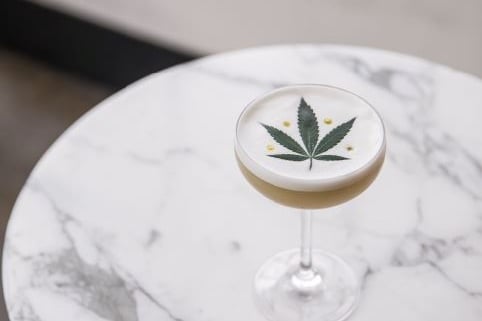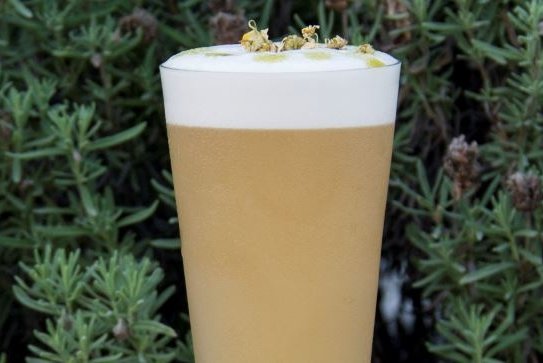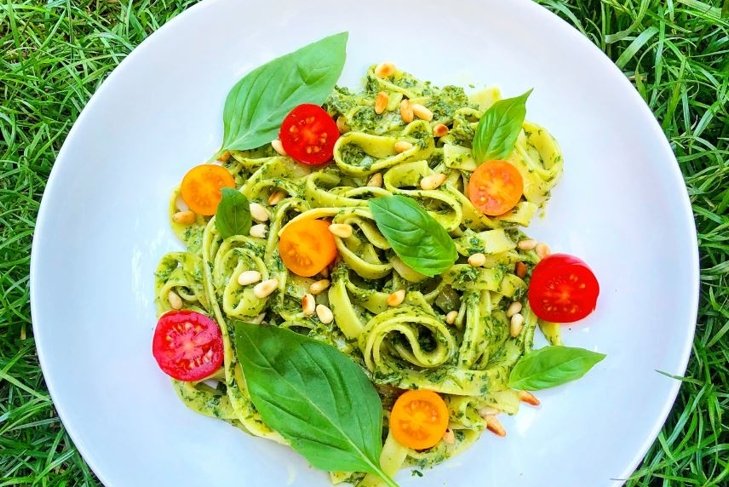
I was feeling creaky after a transatlantic flight, limbs having been shoved into 90-degree angles for more than nine hours. Despite compression socks, my ankles were swollen, and my mind was foggy thanks to the multi-hour marathon of movies and recycled air.
Then I remembered a conversation with Chef Julia Jaksic, the mastermind behind Cafe Roze, an all-day eatery in my Nashville neighborhood. With its millennial pink accents and storefront windows streaming in sunshine, Cafe Roze is a small restaurant making a big impact on plant-forward, healthy eating in Nashville.
Cafe Roze sells lattes and other drinks infused with CBD (cannabidiol), the non-psychoactive compound in the cannabis plant—widely available as CBD oil derived from hemp—that’s credited with everything from boosting relaxation to reducing pain and inflammation. Jaksic herself has been taking CBD as a supplement for years to calm anxiety. She created Cafe Roze’s CBD offerings, including CBD dressings for the restaurant’s generous salads, for customers who were curious about the benefits.*
“It is shocking how popular it is,” she told me.
If there was ever a day I wanted a natural anti-inflammatory and mental fog-lifter, it was after that plane ride. So I headed to Cafe Roze for a matcha and orange blossom latte whose earthy texture reminded me of when I was loyal to a daily wheatgrass shot. Five spheres of CBD oil floated on top of the thick green foam.
From the first sip, I felt connected to the power of plants again.
Research varies on how long it can take to feel the effects of CBD. It’s certainly not like popping an Advil (at least not for me), but after the drink, I did feel a little more focused and less stiff. By the time I made it from Cafe Roze to my gym, my ankles were back to preflight size.
Later in the week, I headed to Walden, a neighborhood bar, for a nonalcoholic CBTea made with chamomile tea, pear juice (another anti-inflammatory), aquafaba, and demerara. (Nab this CBTea reipe!). The lack of stiffness continued. I don’t know that I can credit CBD entirely, but it was enough to make a journalist curious about who’s cooking with CBD and why.
Making healthy dishes even better
“More people are healthy and aware of the health benefits of food now than in any other time in my life,” says Tony Galzin, the chef and co-owner of Nicky’s Coal Fired, a Nashville restaurant that has added CBD to special dishes on an experimental basis. “I’m interested in the health benefits,” he says of CBD, “but also the natural flavors, for me, are a culinary challenge. It is like working with turmeric and ginger.”
The addition of CBD is a good fit with the philosophies behind a plant-based diet, making plant-centric menus good candidates for CBD-infused foods.
Throw a CBD-themed dinner party
Part of the fun of being a home cook is experimenting with new ingredients with friends and family. Let your guests know what you’ve got planned in advance and empower them to manage their own CBD intake.
Place card-style signage with the dosage in each dish may be helpful, and CBD recipe developer Leah Vanderveldt suggests designing a few dishes that guests can add their own CBD oil or CBD-infused sauce to (so that they can skip it for a course or two if they prefer). Note that CBD might not be appropriate for all people, including pregnant women and people on certain blood thinners or medications that are changed by the liver.
La vie en roze Chef Julia Jaksic of Cafe Roze in Nashville has pioneered CBD-infused dining in the city. Left: “The GateWay,” available as a vegan mocktail at Cafe Roze, is one of THE RESTAURANT’S CBD creations.
“I consider CBD a plant medicine, so using it in combination with other plants just made sense to me,” says Leah Vanderveldt, author of The CBD Kitchen. “It’s an area of cooking that encourages my creativity and makes me think about ingredients from both the perspective of nourishment and the environment.”
I asked visionary chefs and recipe developers like these for their tips on making vegan eats and drinks with CBD, as well as recipes to get anyone cooking confidently with CBD (see CBTea recipe).
Here’s what they had to say.
Choose your method
Vanderveldt supports taking CBD as a supplement and using it in food and drink. “To me, the advantage of cooking with it is being able to combine it with other health-promoting foods for supercharged benefits, as well as masking the sometimes strong flavor that doesn’t always agree with people,” she says.
What’s that flavor? Think earthy and similar to herbs like oregano and cilantro, says Vanderveldt.
Galzin, meanwhile, leans into the flavor when possible. He recently created a pizza, the base of which had a hemp flower pesto (with garlic and olive oil) that gave the pizza an earthy aroma. He sliced pineapple and compressed it with CBD oil in a Cryovac vacuum-packaging machine, allowing the pineapple to absorb the oil. (You can replicate this process at home by marinating pineapple in CBD oil and a sea salt solution in a resealable bag in your fridge. It’s a chef hack that’s ideal for fruits in salads and other dishes.)
Galzin’s CBD supplier uses CBD suspended in coconut oil, which the chef concedes may not be his first choice in an Italian recipe, but is perfect with pineapple, imbuing the fruit with a subtle coconut taste.
Beau Kelly-Fontano, bar director at Entente, a Michelin-starred restaurant in Chicago, has had great success with a spirit-free CBD cocktail he’s got on the menu. He also uses hemp-derived CBD in a coconut oil base, in part because the CBD is then visible as a pearlescent globe floating on top of other liquids. He likes working with more transparent CBD oils, as opaque varieties can have a lotion-like texture.
Don’t like it hot
Industry pros note that CBD is being added to beverages at a more rapid pace than to foods. At Cafe Roze, CBD oil can be added to any drink for an additional $5, and Jaksic says most customers opt to add it to lattes (in which hemp milk is also an option).
Charlotte Kjaer, a chef based in the United Kingdom who specializes in CBD-infused vegan and vegetarian dishes, notes that hemp has a low smoke point. Heating the CBD too high will potentially destroy any functional properties, and, she adds—just as important to any chef—it won’t taste good. You don’t have that concern with most drinks.
“You do not want to throw it in a pan and sauté with it,” agrees Jaksic. Treating CBD oil like a cold-pressed oil is a good guideline, she says.
Baking with CBD makes a lot of sense, particularly with CBD suspended in coconut oil. The coconut oil supplies some of the necessary vegan fat for baking, as well as a nutty flavor. Remember to bake your goods at moderate temperatures—preferably 350 F or lower.
Just because you’re not blasting it with heat doesn’t mean you can’t cook with CBD. Kjaer has spent years developing dishes using CBD, including a pesto on pasta (we’ve got the recipe on p. 57!), scrambled chickpea tofu, and a cauliflower steak marinated in za\’atar served with tahini cream with CBD oil. Vanderveldt’s The CBD Kitchen includes recipes for sauces, entrees, and more—all of them plant based (peep three of our favorites here – CBD Leek and Zucchini Soup, CBD Raw Oatmeal Cookie Bites, and Grilled Lettuce, Chickpea, and Radish Salad with Miso and Garlic CBD Vinaigrette).
The deal with dosages
Playing around in the kitchen with CBD requires paying attention to dosage, just as you’d watch the quantity of sodium or spice you’d add to another recipe. Most CBD manufacturers provide dosing information on their oils and tinctures, and chefs tend to adhere to those, as the manufacturers know the concentration of their products. You’ll need to read product labeling carefully and engage in some trial and error. Remember: It’s easier to add than subtract, so start small and then up the dosage if you’re not getting the desired results.
In general, Kjaer adds 3 to 4 mg per serving for starters and desserts and 5 mg for entrees. “Don’t overdo it,” she cautions. When baking, for example, she’ll make a cake with traditional vegan ingredients and then put the CBD in the frosting. She might have a starter, an entree, and a dessert on a menu that all contain CBD, but she and others recommend not trying all three at once.
Basically, you’ll want to ease into CBD eats and drinks and pay attention to how your body responds.
“It is one of those things that is different for everyone,” says Jaksic. “Some people treat it like a novelty, and some look for specific benefits. But we see all walks of life come in and try it.”
Where to find delicious vegan CBD eats and drinks
These American restaurants are adding CBD tinctures and oils to their plant-based offerings, and we’re here for it.
- Plant Miamioffers vegan and kosher foods with a signature aesthetic synonymous with the local Florida landscape. Nab the orange ice cream sandwich made with CBD and essential oil.
- Fuel, a Philadelphia chain with plant-based options, will add CBD oil to acai bowls, smoothies, and anything else on the menu for an extra $2.95.
- VegeNation, Las Vegas’s plant-based community eatery, has a number of beverages made with its CBD-infused tea.
- Zenbarn isn’t entirely plant based, but options like seitan make it a vegan-friendly destination in Waterbury, VT. Salads can be topped with CBD dressings.
One caveat: Because enforcement of laws governing CBD in foods are in flux (see “Regulation of CBD in restaurants: It’s complicated ”below), it’s wise to check ahead before you go to a restaurant to find a specific CBD dish. Expect to pay an additional $3 to $5 for CBD as an ingredient.
Regulation of CBD in restaurants: It’s complicated
While hemp-derived CBD is legal in America, CBD in food sold by restaurants is a complicated gray area. The 2018 Farm Bill (officially the Agricultural Improvement Act of 2018) legalized hemp, but the U.S. Food and Drug Administration (FDA) hasn’t approved CBD as a food additive.
At the state and local level, regulations vary wildly. The Colorado Department of Public Health and Environment, for example, has stated that “the use of all parts of the industrial hemp plant is allowed as a food ingredient in Colorado.” Some other states and health departments don’t allow CBD in food. Earlier this year, New York City health inspectors told restaurants to stop selling foods and beverages containing CBD. Health inspectors have also cracked down in Los Angeles.
Many chefs are optimistic that laws will change quickly to allow CBD in restaurants across the country. Indeed, the FDA issued a statement in July that acknowledged the agency “is exploring potential pathways for various types of CBD products to be lawfully marketed.”
Of course, it’s simple (and legal and affordable) to experiment with cooking with hemp-derived CBD at home!
For when you’re feeling fancy – delish CBD recipes from chefs
CBTea

Hemp and Carrot Top CBD Pesto with Pasta

Ready to go all in?
There are plenty of other hemp-derived ingredients worth introducing to your kitchen. In addition to CBD oils, some chefs use hemp flour and hemp seeds. These products are derived from other parts of the hemp plant, and they don’t contain CBD. They can add an earthy taste to dishes, not to mention additional protein (always a plus in vegan cooking!).
For when you’re in a hurry – easy recipes from the CBD Kitchen
CBD Leek and Zucchini Soup

CBD Raw Oatmeal Cookie Bites

Radish Salad with Miso and Garlic CBD Vinaigrette

Want to know more? We recommend reading – Your CBD Schedule.
CBD Leek and Zucchini Soup; CBD RAW OATMEAL COOKIE BITES; Grilled Lettuce, Chickpea, and Radish Salad with Miso and Garlic CBD VinaigrettE; and “Your CBD Schedule” excerpted from The CBD Kitchen by Leah Vanderveldt, published by Ryland Peters & Small ($19.95). Photography by Clare Winfield © Ryland Peters & Small.
Used with permission from the publisher.









